The Intel Haswell-E CPU Review: Core i7-5960X, i7-5930K and i7-5820K Tested
by Ian Cutress on August 29, 2014 12:00 PM ESTEvolution in Performance
The underlying architecture in Haswell-E is not anything new. Haswell desktop processors were first released in July 2013 to replace Ivy Bridge, and at the time we stated an expected 3-17% increase, especially in floating point heavy benchmarks. Users moving from Sandy Bridge should expect a ~20% increase all around, with Nehalem users in the 40% range. Due to the extreme systems only needing more cores, we could assume that the suggested recommendations for Haswell-E over IVB-E and the others were similar but we tested afresh for this review in order to test those assumptions.
For our test, we took our previous CPU review samples from as far back as Nehalem. This means the i7-990X, i7-3960X, i7-4960X and the Haswell-E i7-5960X.
Each of the processors were set to 3.2 GHz on all the cores, and set to four cores without HyperThreading enabled.
Memory was set to the CPU supported frequency at JEDEC settings, meaning that if there should Intel have significantly adjusted the performance between the memory controllers of these platforms, this would show as well. For detailed explanations of these tests, refer to our main results section in this review.
Average results show an average 17% jump from Nehalem to SNB-E, 7% for SNB-E to IVB-E, and a final 6% from IVB-E to Haswell-E. This makes for a 31% (rounded) overall stretch in three generations.
Web benchmarks have to struggle with the domain and HTML 5 offers some way to help use as many cores in the system as possible. The biggest jump was in SunSpider, although overall there is a 34% jump from Nehalem to Haswell-E here. This is split by 14% Nehalem to SNB-E, 6% SNB-E to IVB-E and 12% from IVB-E to Haswell-E.
Purchasing managers often look to the PCMark and SYSmark data to clarify decisions and the important number here is that Haswell-E took a 7% average jump in scores over Ivy Bridge-E. This translates to a 24% jump since Nehalem.
Some of the more common synthetic benchmarks in multithreaded mode showed an average 8% jump from Ivy Bridge-E, with a 29% jump overall. Nehalem to Sandy Bridge-E was a bigger single jump, giving 14% average.
In the single threaded tests, a smaller overall 23% improvement was seen from the i7-990X, with 6% in this final generation.
The take home message, if there was one, from these results is that:
Haswell-E has an 8% improvement in performance over Ivy Bridge-E clock for clock for pure CPU based workloads.
This also means an overall 13% jump from Sandy Bridge-E to Haswell-E.
From Nehalem, we have a total 28% raise in clock-for-clock performance.
Looking at gaming workloads, the difference shrinks. Unfortunately our Nehalem system decided to stop working while taking this data, but we can still see some generational improvements. First up, a GTX 770 at 1080p Max settings:
The only title that gets much improvement is F1 2013 which uses the EGO engine and is most amenable to better hardware under the hood. The rise in minimum frame rates is quite impressive.
For SLI performance:
All of our titles except Tomb Raider get at least a small improvement in our clock-for-clock testing with this time Bioshock also getting in on the action in both average and minimum frame rates.
If we were to go on clock-for-clock testing alone, these numbers do not particularly show a benefit from upgrading from a Sandy Bridge system, except in F1 2013. However our numbers later in the review for stock and overclocked speeds might change that.
Memory Latency and CPU Architecture
Haswell is a tock, meaning the second crack at 22nm. Anand went for a deep dive into the details previously, but in brief Haswell bought better branch prediction, two new execution ports and increased buffers to feed an increased parallel set of execution resources. Haswell adds support for AVX2 which includes an FMA operation to increase floating point performance. As a result, Intel doubled the L1 cache bandwidth. While TSX was part of the instruction set as well, this has since been disabled due to a fundamental silicon flaw and will not be fixed in this generation.
The increase in L3 cache sizes for the highest CPU comes from an increased core count, extending the lower latency portion of the L3 to larger data accesses. The move to DDR4 2133 C15 would seem to have latency benefits over previous DDR3-1866 and DDR3-1600 implementations as well.


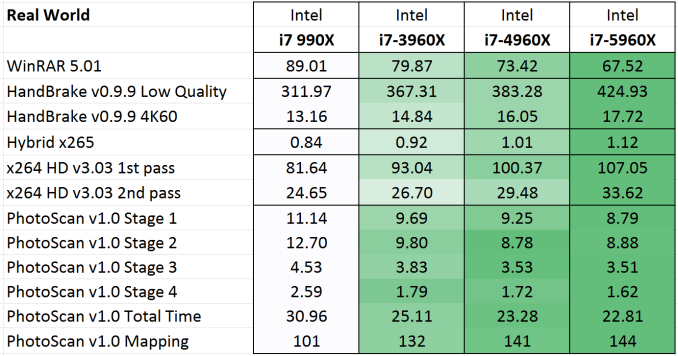


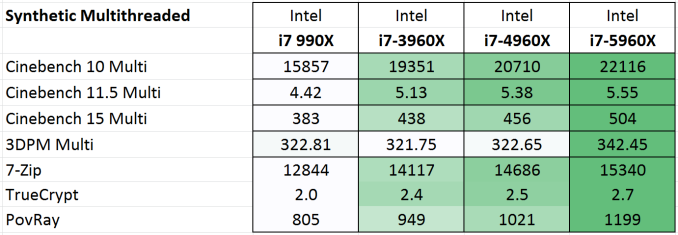

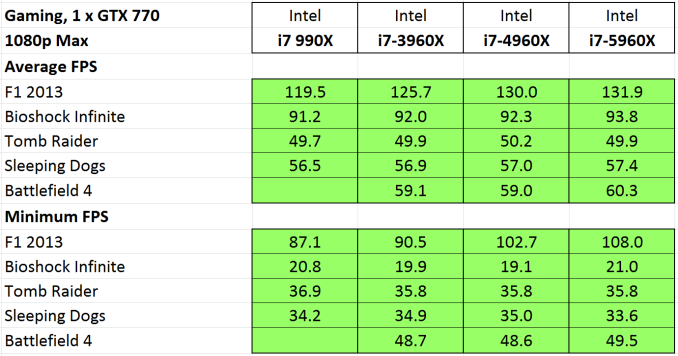
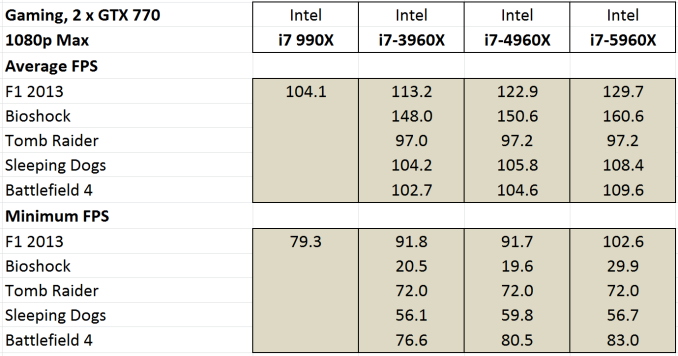
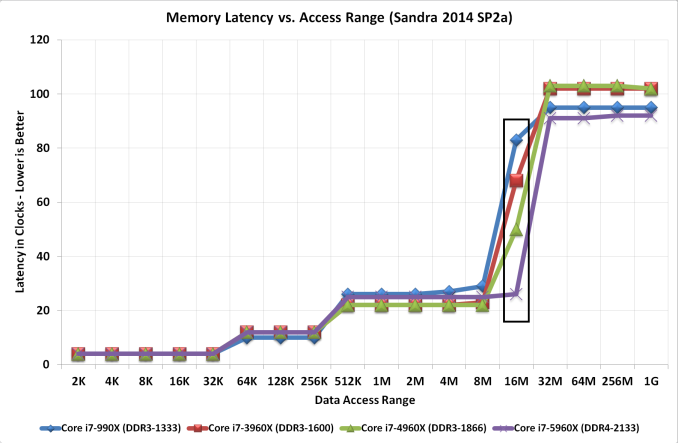








203 Comments
View All Comments
wireframed - Saturday, August 30, 2014 - link
I'm guessing you don't do much animation? :) Even though many of my renders only run around 10-20 minutes max, when you do a 30s animation, you can multiply that rendertime by 900... Even for a minute a frame (which is fairly fast), that's still 15 hours.But I think the main draw for people on X58 like us, is the newer platform. X58 is really low on modern features, it came out at an awkward time. No native USB 3.0, no 6Gbps SATA, no Thunderbolt (which might be relevant in the future), no PCIe 3.0, and no support for the newer standards coming out with Z97.
Also consider DDR4 is going to be the standard going forward, so investing a lot of money in 32-64GB of DDR3, even at the lower prices, just seems like throwing good money after bad.
Kain_niaK - Saturday, August 30, 2014 - link
You are right! When I talking about a render, I am talking about exporting a music project to separate wave files (one per track). You can either record while playing it back or you can render it. Most VST plugins have a render mode as well so the end result is sometimes quite different. Not necessarily better, but different. And recording is done in real time, so sometimes a render is a lot faster.kevith - Friday, August 29, 2014 - link
Right on!bebimbap - Friday, August 29, 2014 - link
the 31% is at the same frequency.being able to do double the work with the same amount of energy or the same work with 1/2 the energy is a big deal.
imagine if cars could do that... 2x the horsepower but same amount of gas... or the same mileage at 1/2 the gas
Laststop311 - Friday, August 29, 2014 - link
ive been happily on my x58 i7-980x for 4 years and honestly if my chipset wasn't missing so many modern features i wouldn't even upgrade. But the lack of pci-e 3.0 lack of sata 3 lack of usb 3.0 are just becoming a pain in the ass. ur circo 2008 is wrong too i know because i got the i7-980x right when it came out and it was in 2010 not 2008 so that would be 100-110% over 4 years.I really want an ultra m2 pci-e 3.0 x4 drive as my main os and application drive. Can't wait to pop in a 1TB samsung sm951 ultra m2 drive. Also cant wait for the 16GB DDR4 sticks to start showing up. 8x16GB 128GB of ram, can you say 112GB ram drive and 16GB ram for the system. It's gotta be awesome working on video editing with your entire video in a super fast ram drive. My memory and storage is what's going to boost the performance for me gtom my x58 the cpu will too but not like the ultra m2 ssd with like 1400MB/sec read and 1200MB/sec write
nonoverclock - Saturday, August 30, 2014 - link
I recently went from an i7-950 to a i7 4770. It's made for a solid bump in performance. I notice it particularly in navigating game menus that used to be a little sluggish before.Railgun - Friday, August 29, 2014 - link
Sold! As I'm still on Gulftown, this is just what the doctor ordered. The i7-970, IMHO, has held its own for four years, at least for my needs. This will be one helluva shot in the arm.PEJUman - Friday, August 29, 2014 - link
with you on this. I actually sold my gulftown with 48GB last year for the 6xSATA on z87, The x58 + gulftown is one heck of a system. If I don't already have the 4770k, this 5960 or 5820 would be extremely difficult to resist.I actually tempted to mount the mobo+CPU+intel sink on the wall instead of selling it, it was a piece of computing history.
bebimbap - Friday, August 29, 2014 - link
If i remember the weight of that particular heatsink, you would need a sturdy mount for your wall... thumbtacks do not applyLaststop311 - Saturday, August 30, 2014 - link
48gb on gulftown thats strange considering gulftown supports 24gb ram. http://ark.intel.com/products/47932right on intel's page. i sense a fibber. Why lie about what pc u have?